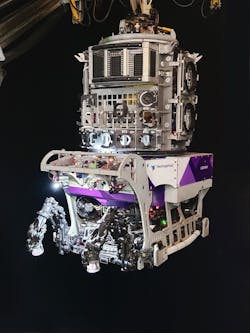TechnipFMC has recently introduced Gemini, an advanced workclass ROV, deploying two systems for Shell Offshore Inc. Working in support of the company’s deepwater drilling and completion operations, Gemini is being used for wellhead installation, BOP deployment, daily riser inspections, as well as subsea tree installation and commissioning.
At 250 hp (186 kW) and a depth rating of up to 13,123 fsw (4,000 m), Gemini has been designed to address the comprehensive range of tooling and fluid intervention tasks that will be performed, featuring subsea interchangeability of over 30 tools and access to over 100 gallons (3.8 L) of intervention fluid. This level of functionality is available at the subsea worksite for one-month duration, since there is no longer a need to return to surface for frequent system reconfiguration.
“Historically, the industry has accepted the non-productive time of ROVs being launched and recovered, system reconfiguration and maintenance time on deck, plus any delays in launching due to poor weather conditions,” said Bernard McCoy Jr., TechnipFMC’s Vice President Subsea Wells and ROV Global Service Lines. “In 2015, we determined that the next generation of ROVs needed to deliver a step-change in reducing this non-productive time and reduce the total cost of ownership for our customers. This led to the development of the Gemini ROV system.”
Fundamentally, ROVs have been stand-alone systems that rely on manipulators being added to the ROV, and then tooling added to perform specific tasks. Configuring the ROV, manipulators and tooling has been a highly skilled task, requiring crews to have comprehensive expertise in a multitude of skills, such as hydraulics, electrical systems, electronic and mechanical interfaces.
Additionally, the ROV pilots require the spatial awareness and operational experience to perform challenging intervention tasks subsea. This reliance on human skills has resulted in a wide range of outcomes and is difficult to resolve through training alone.
In contrast, Gemini is a fully integrated system featuring machine vision and precision robotics that enable operators to perform intervention tasks consistently and efficiently. As a result, Gemini’s operations take significantly less time to accomplish with consistent results and within predictable timeframes.
The duration of Gemini’s four-year development process was primarily due to the time needed to mature its significant technological advancements. During the initial product development phase, extensive simulation testing was performed to determine the key criteria that would enable automation and precision robotics in the deepwater environment. This challenge was more complex than automating land-based robots, simply because the ROV is buoyant in water and has to interact with subsea hardware, not to mention the complexities associated with marine life and particles in the water affecting vision systems.
McCoy added: “We determined that making a significant advancement in the ROV’s ability to stay precisely in position was key, and Gemini has the ability to stay on position in 2 knot currents with an accuracy of 1 in. (25 mm). In addition to this refinement in position control, we utilize five machine vision cameras on the ROV. The machine vision system is able to recognize fixed points such as an intervention panel and uses this information for both position control and manipulator/tooling automation.”
A key technology imbedded within the Gemini system is the use of fiducials. Resembling QR codes, these fiducials are visual references for the robot’s machine vision cameras and they assist with the identification of each tool and its respective position. This additional reference point enables the machine vision system to rapidly determine the trajectory that the manipulator must take to acquire or stow any particular tool.
Gemini’s automation aspects are not simply pre-programmed functions. The ROV assesses each situation and makes intelligent decisions based on what is viewed through the cameras. Even without the fiducial reference, the machine vision system enhances the interaction with subsea production system equipment such as BOPs or subsea trees. The camera system accomplishes this by detecting fixed points, such as the edge of an intervention panel and the interface receptacles for hot stabs and torque tools. These fixed points then provide a reference for positional information and enable stability and interaction with the subsea equipment.
As automation becomes an increasingly common aspect of the offshore industry, Gemini is designed to enable supervised autonomy, whereby the ROV pilot remains in control of the outcome at all times, albeit assisted by the ROV’s automation capabilities. TechnipFMC sees supervised autonomy as a foundation stone for making significant strides in ensuring that highly skilled project personnel are offshore to engage with project operations, while reducing the need for product-specific expertise which can be provided from remote engineering teams.
The combination of precision robotics and intelligent machine vision-based automation are fundamental enablers for the development of additional value creating solutions. In this regard, McCoy commented: “Gemini will be a hub for integrating additional services, both from the perspective of interacting with subsea equipment and data acquisition. Additionally, such technology advancements enable the integration of offshore crews since they can now focus on the outcome of the project, more than purely having to be experts in one particular service technology.”
Gemini’s deployment is part of TechnipFMC’s initial phase in its roadmap for advancing deepwater robotics and automation offshore, as its design encompasses core technologies that will enable rapid expansion of system capabilities. The deployment of additional features in the company’s next phase will be similar to downloading a new app for a smartphone.



